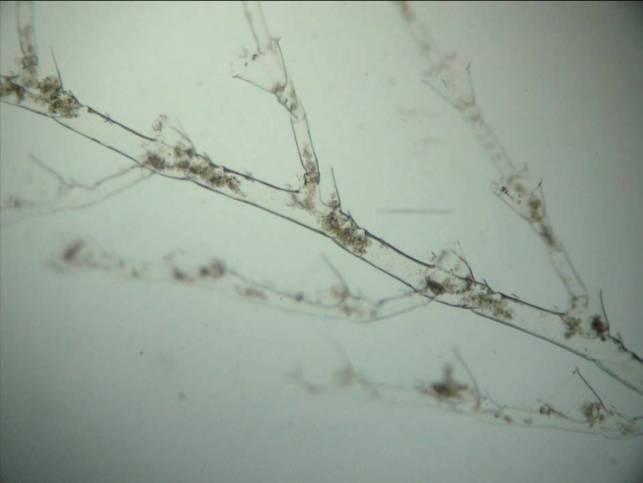Invasion History
First Non-native North American Tidal Record:First Non-native West Coast Tidal Record:
First Non-native East/Gulf Coast Tidal Record:
General Invasion History:
The hydroid Halopteris alternata was described by Nutting in 1900, from Barracuda Rocks in the Bahamas. It is widely distributed in the coastal Western Atlantic from North Carolina to Brazil. It is a member of genus with many species. It has often been confused with H. diaphana, a predominantly Eastern Atlantic species (Schuchert 1997). Eastern Atlantic populations are known from Madeira, the Canary Islands, and the Cape Verde Islands, and are considered cryptogenic (Ansín Agís et al. 2001).
North American Invasion History:
Invasion History Elsewhere in the World:
In 2018, two specimens of Halopteris alternata were collected at the Salinas Yacht Club, Ecuador. In 2018, multiple specimens of H. alternata were collected in Chatham Bay, Costa Rica (Calder et al. 2022).
Description
Halopteris alternata (Nutting 1900) is a marine hydroid described from the Bahamas. It grows as plumes, with alternating branches arising from branching stolons. The basal portion (~25%) is devoid of branches and hydranths. The basal part is divided by 2–3 nodes and the branches are also segmented by nodes. The nodes are cup-shaped or conical. The segments bear nematothecae, structures bearing small conical clumps of nematocysts. The hydrothecae are cup-shaped, with a smooth margin. Gonothecae of both sexes can arise on the same plume and from the stem or the branches. The female gonothecae are somewhat elliptical, with a curved base and are truncated, with a complex lid, ~8 mm long. Male gonothecae are smaller and oblong, with a rounded distal end. The plumes are 7–20 mm tall. A medusa is not known for this species (Schuchert 1997; Torres-Rodriguez et al. 2020).
Taxonomy
Taxonomic Tree
| Kingdom: | Animalia | |
| Phylum: | Cnidaria | |
| Class: | Hydrozoa | |
| Family: | Halopterididae | |
| Genus: | Halopteris | |
| Species: | alternata |
Synonyms
Thecocaulus diaphana ( Vannucci-Mendes, 1943)
Schizotricha billardi Schizotricha billardi (Vannuci, 1951)
Antennella diaphana diaphana (Van Gemerden-Hoogeveen, 1965)
Halopteris d. diaphana (Vervoort, 1968)
Potentially Misidentified Species
Halopteris alternata 'had commonly been misidentified earlier in the region as H. diaphana (Heller, 1868), a species best known in waters of Europe' (Calder 2021).
Ecology
General:
The hydroid occurs on attached and floating algae, often Sargassum, and often on coral fragments, sponges and stones, coral reefs, mangroves, and pilings, from the lower intertidal to 17m depth (Dalder 2019). This hydroid is found at marine salinities, under tropical and subtropical conditions, although it can be transported as far north as New Jersey by the Gulf Stream (Calder 2019).
Food:
Zooplankton, epibenthos
Consumers:
Competitors:
Trophic Status:
Suspension FeederHabitats
| General Habitat | Marinas & Docks | None |
| General Habitat | Rocky | None |
| General Habitat | Coral reef | None |
| General Habitat | Mangroves | None |
| Salinity Range | Polyhaline | 18-30 PSU |
| Salinity Range | Euhaline | 30-40 PSU |
| Tidal Range | Subtidal | None |
| Vertical Habitat | Epibenthic | None |
Life History
The hydrozoan Halopteris alternata lacks a planktonic medusa, and grows as a polyp colony, reproducing sexually to produce planula larvae, which settle to form new polyps (Barnes 1983).
Tolerances and Life History Parameters
| Maximum Height (mm) | 20 | None |
| Broad Temperature Range | None | Subtropical-Tropical |
| Broad Salinity Range | None | Poly-Euhaline |
General Impacts
No impacts have been reported for introduced populations Halopoteris alternata.
Regional Distribution Map
Non-native
Native
Cryptogenic
Failed
Occurrence Map
References
Ansín Agís J.; Ramil F.; Vervoort. W. (2001) Atlantic Leptolida (Hydrozoa, Cnidaria) of the families Aglaopheniidae, Halopterididae, Kirchenpaueriidae and; Plumulariidae collected during the CANCAP and Mauritania-IIexpeditions of the National Museum of Natural History,Leiden, the Netherlands, Zoologische Verhandelingen 333: 1-268Calder, Dale R. (2019) On a collection of hydroids (Cnidaria, Hydrozoa) from the southwest coast of Florida, USA, Zootaxa 4689(1): 1-141
Calder, Dale R. and 8 authors (2021) Additions to the hydroids (Cnidaria, Hydrozoa) of marine fouling communities on the mainland of Ecuador and in the Galapagos Islands, Aquatic Invasions 16: 208-252
Calder, Dale R.; Carlton, James T.; Keith, Inti; Ashton, Gail V. ;Larson, Kristen; Ruiz, Gregory M.; Herrera, Esteban; Golfin, Geiner (2017) Biofouling hydroids (Cnidaria: Hydrozoa) from a tropical Eastern Pacific island, with remarks on their biogeography, Journal of Natural History 56(9-12): 565-606
https://doi.org/10.1080/00222933.2022.2068387
Calder, Dale R.; Carlton, James T.; Larson, Kristen; Mallinson, Jenny J.; Choong, Henry H. C.; Keith, Inti; Ruiz, Gregory M. (2019) Hydroids (Cnidaria, Hydrozoa) from marine fouling assemblages in the Galápagos Islands, Ecuador, Aquatic Invaders 14: 21-58
Calder, Dale R.; Kirkendale, Lisa (2005) Hydroids (Cnidaria, Hydrozoa) from shallow-water environments along the Caribbean coast of Panama., Caribbean Journal of Science 41(3): 476-491
Calder, Dale; Faucci, Ansuschka (2021) Shallow water hydroids (Cnidaria, Hydrozoa) from the 2002 NOWRAMP cruise to the Northwestern Hawaiian Islands, Zootaxa 5085(1): 1-73
https://doi.org/10.11646/zootaxa.5085.1.1
Moura, Carlos J.; Collins, Allen G.; Santos, Ricardo S.; Lessios, Harilaos (2019) Predominant east to west colonizations across major oceanic barriers: Insights into the phylogeographic history of the hydroid superfamily Plumularioidea, suggested by a mitochondrial DNA barcoding marker, Ecology and Evolution 9: :13001–13016.
DOI: 10.1002/ece3.5608
Oliveira, Otto M. P. and 24 authors (2016) Census of Cnidaria (Medusozoa) and Ctenophora from South American marine waters, Zootaxa 4194: 1-256
Schuchert, P.P. (1997) Review of the family Halopterididae (Hydrozoa, Cnidaria), Zoologische Verhandelingen 309: 1-162
Torres-Rodroguez, Javier; Daniel Ortiz-Oola; ; Puentes-Sayo, Alejandra; Lecompte, Orlando P; Jauregui, Aminta (2020) Genetic And Morphologic Identities Of Hydrozoans (cnidaria, Hydrozoa) From Reef Patches Of Santa Marta, Colombian Caribbean, Zootaxa 4758(1): 127-140
